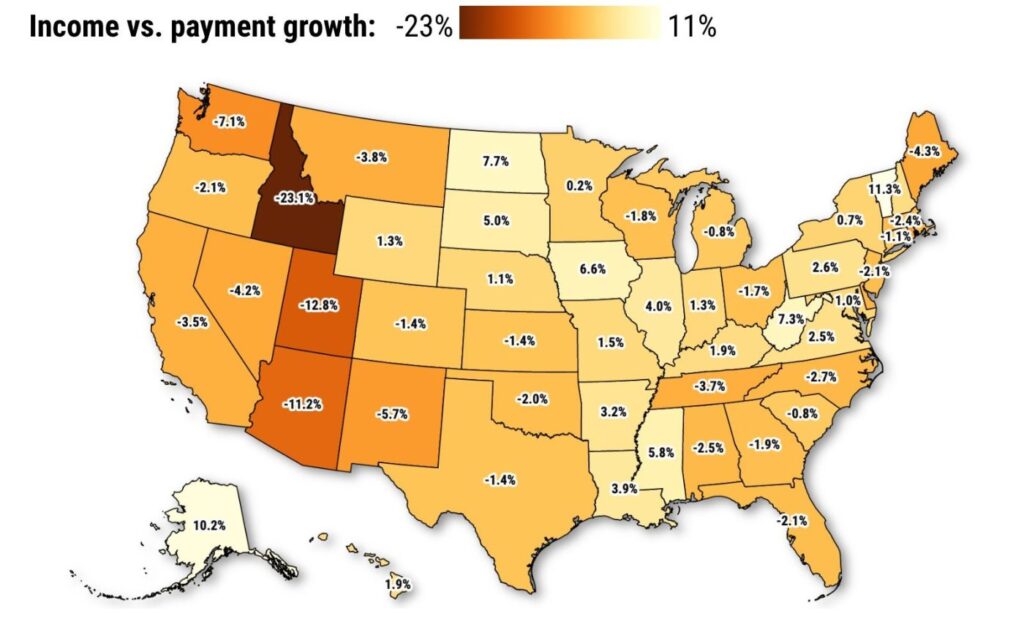
Let’s remember how we got into this latest housing affordability pickle: It’s largely the Federal Reserve’s fault.
The pandemic era’s homebuying frenzy grew into bubble status primarily due to historically low mortgage rates. Cheap financing made giant price gains more palatable than you might think.
But with those mortgage-rate gifts now a distant memory, a house hunter’s how-much-can-I-buy math doesn’t add up easily.
Forget all the chatter from so-called experts about how limited supply, urges for bigger spaces, and sudden millennial demand combined to create the pandemic’s feeding frenzy. This homebuying binge was primarily the result of the nation’s central bank using deeply discounted financing to help keep a coronavirus-chilled economy afloat.
Unfortunately, that housing bailout – plus lots of other government help – created 40-year high inflation. To fix that economic headache, the Fed’s cheap-money handouts morphed into surging interest rates that effectively iced the housing market.
The gift
Let’s not forget the heft of the Fed’s pandemic-era generosity.
I filled my trusty spreadsheet with average home pricing, income, and interest rate stats from Zillow, LendingTree, and several government agencies, comparing pre-pandemic 2019 with steamy 2021 and chilly 2022.
Start with the obvious: California housing costs are nutty high. In 2021, the state’s median home value ranked No. 2 nationally at $672,347 vs. $277,249 nationwide.
And that was after noteworthy pandemic-era gains in California – up 23% from 2019, the No. 13 gain among the states. Nationally, prices rose 21%.
Next, ponder the paychecks trying to afford those home prices.
In 2021, California ranked No. 5 among the states with an $84,900 median household income vs. $66,500 nationally. And from 2019 – after two good years for many workers – Californians enjoyed the 27th-largest raises at 5.6% vs. up 5.8% nationally.
So, you look at these stats and you might easily conclude that incomes badly trailed price gains.
California’s home appreciation was 17.7 percentage points faster than raises – and only 10 states had larger gaps. The 50-state spread between hikes in prices and wages was 15 points.
It’s the payment, stupid
The typical house hunter is focused on how much mortgage they can afford monthly.
And the Fed’s 2020-21 rate cuts dramatically “boosted” affordability. Mortgage rates that averaged 3.9% in 2019 fell to 2.96% by 2021.
That financing giveaway created an estimated monthly house payment of $2,256 in California in 2021, assuming 20% down on a $672,300 median. By the way, that was the second-highest payment in the U.S. Nationally, the estimated payment was $930.
After the Fed’s rate cuts are factored in, California payments were up just 9.1% in two years (the No. 13 gain among the states). Nationally, payments rose only 6.3% in 2019-21.
Much of the pandemic era’s homebuying stupidity can be bargain-priced mortgages.
Remember, California incomes grew 5.6% income growth in the pandemic’s first two years. The monthly cost to finance a California home grew only 3.5 percentage points faster than the pay raises of 2019-21.
And national price gains topped raises by only 1.2 percentage points.
New math
Once cheap money died, most house-hunting budgets were obliterated.
Sales activity crashed in 2022 and now prices have started to retreat. Consider the ugly math using a 5.1% mortgage rate, the average for this year’s first 10 months.
First, home prices were rising until recently. California values were up an average 15% through October vs. a 13% national price gain.
Then add in mortgage rates, up 2 percentage points on average, this year vs. 2021.
That ballooned an estimated payment, pushing it up 48% for California house hunters, only the 22nd-largest jump among the states. Nationwide, the payment gain averaged 47%, topped by Florida at 65%, then Tennessee at 59%, Georgia at 58%, South Carolina at 58%, and Nevada at 57%.
Do not forget, this math assumed a 5.1% mortgage rate. Trust me, you don’t want to know the tally using November’s 6.8% rate.
No friends
Basically, central bankers went from housing heroes to bubble-bursting devils.
The major hurdle housing faces as it enters 2023: No friends at the Fed.
The central bank’s chairman, Jerome Powell, warned on Dec. 14 the interest rates the Fed controls will go even higher next year – and stay elevated – in the struggle to tame inflation.
“Restoring price stability will likely require maintaining a restrictive policy stance for some time,” he said after the Fed raised rates for the seventh time in 2022.
Not only does pricier financing make homebuying harder, but it also weakens the broader economy. And a skittish job market is also a drag on housing.
So unless the central bank caves on its plans to use high rates to chill inflation, homebuying will remain icy cold – with greatly depressed sales and weakening pricing.
Jonathan Lansner is the business columnist for the Southern California News Group. He can be reached at jlansner@scng.com
